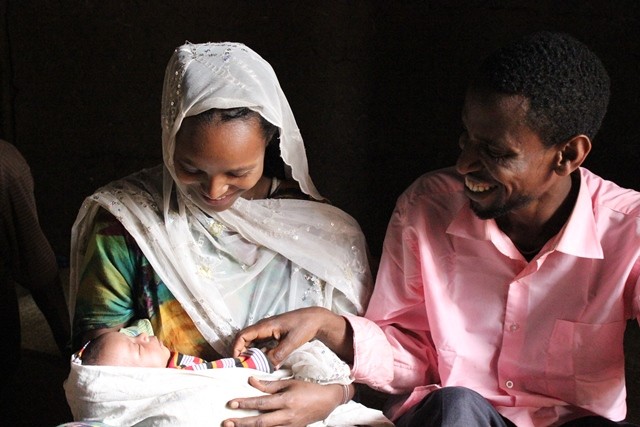
Dec. 2014—Five years ago, Nefisa Hassen, a 24-year-old farmer from Ethiopia, had her first child at home. The labor and birth were prolonged and difficult. She prayed that, when her time came to deliver, she wouldn’t have complications forcing her to go to the health center. She could not handle the pity of her neighbors if she was unable to have a normal birth, and she wasn’t certain her husband could cover the cost of transportation to the facility.
But for her next pregnancy, Nefisa was better prepared.
Kassech Bekele is a health extension worker. One of her responsibilities is to visit households in the Yanga kebele, or neighborhood, working particularly with pregnant women. Using the training in maternal and newborn health she received through the USAID-supported Last Ten Kilometers (L10K) project, Kassech worked long and hard with Nefisa, teaching her the benefits of giving birth at the Shebe Health Center. When she reached her eighth month, Nefisa and her family had finished planning for the birth, including complications that may arise and any additional money they might need, although health centers provide maternal care services free of charge.
When Nefisa went into labor in the middle of the night this past February, she called Kassech, who then called the ambulance driver and the midwife so they could prepare for the delivery at the health center. Nefisa’s sister-in-law took care of her 5-year-old daughter and the household chores at Nefisa's home in Shebe Sombo district, Jimma Zone, Oromia region.
Three weeks after Nefisa delivered at the health center, she reported that everything went smoothly and swiftly. She was especially impressed with the efficiency of Abdulahi Abaselam, the professionally trained male birth attendant. Abdulahi reassured her that he was prepared for any problem that may arise.
In May 2013, Abdulahi received basic emergency obstetric and newborn care training provided by the L10K project. His training included infection prevention procedures, sanitary hand washing, severe preeclampsia and breech delivery. The training expanded his knowledge and clinical skills to respond appropriately to the needs of women during pregnancy, childbirth and the postpartum period as well as the needs of newborns.
“Through training, I have enhanced my skill and become proficient in my job, and this has given me greater confidence. I see that the women are comfortable when they see how confident and efficient you are in the job you do,” he says.
In addition to providing training for health care workers, the L10K project also assisted in renovating the ward and provided essential health care equipment to establish basic emergency obstetric and newborn care service at the Shebe Health Center. Previously, laboring women were referred to the Jimma Hospital, more than 50 kilometers away, for every obstetric complication. This resulted in delays, which aggravated the severity of complications. Furthermore, the cost of transportation to the hospital was a great challenge faced by some families.
As a result of the financial and technical support provided by USAID and the friendly care provided by the health workers, the number of mothers delivering at the Shebe Health Center has doubled since September 2013, reaching over 50 women per month, mostly from nearby neighborhoods. Also, the number of mothers referred to Jimma Hospital has significantly dropped.
Implemented by John Snow Inc., the five-year L10K project, which began in October 2012, increases access to and use of health services for mothers, newborns and children, helping to reduce morbidity and mortality for the three groups in the Amhara, Oromia, Tigray, and Southern Nations, Nationalities and Peoples regions of Ethiopia.
Links
Follow @USAIDEthiopia, on Flickr, on YouTube







Comment
Make a general inquiry or suggest an improvement.